Hot Pepper Disease Management
Chilli leaf curl virus (ChiLCV)
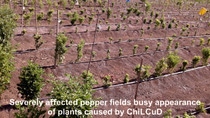
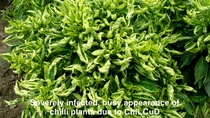
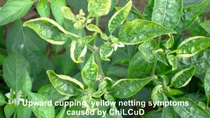
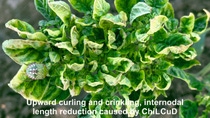
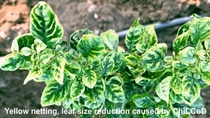
Vector:
Whitefly (Bemisia tabaci)
Taxonomy:
Genus Begomovirus and the family Geminiviridae
Distribution:
Many countries including India
Pathogen:
Chilli leaf curl virus (ChiLCV) is a DNA virus from the genus Begomovirus and the family Geminiviridae. ChiLCV causes severe disease especially in pepper (Capsicum spp.), but also affects other crops. It can be found in tropical and subtropical regions primarily in India but has also been detected in countries such as Indonesia and Sri Lanka. This virus is transmitted by an insect vector the whitefly Bemisia tabaci. The primary host for ChiLCV are several Capsicum spp., but host species also include tomato. ChiLCV has been responsible for several epidemics and causes severe economic losses. It is the focus of research trying to understand the genetic basis of resistance. Currently, a few sources of resistance have been discovered and used to breed resistant varieties. Leaf curl in chili (ChiLCD) is a common disease but recent frequent epidemic outbreaks witnessed repeatedly in the chili growing areas of Central and Southern India is now a growing concern. ChiLCD is the most damaging in terms of yield loss across the cropping regions. In severe cases, even up to 100% losses of marketable fruit have been reported.
Identification:
The symptoms of Chilli leaf curl Virus are characterized by upward curling of leaf margins, yellowing of veins, and reduction of leaf size. Additionally, leaf veins become swollen with shortening of an internodes and petioles. Leaves curl towards midrib and become deformed. Older leaves become leathery and brittle. If plants are infected during the early season, their growth will be stunted, resulting in significant yield reduction. Flower buds abcise before attaining full size and anthers do not contain pollen grains. Fruit formation in infected plants is rudimentary and distorted.
Life Cycle/ Favourable Environmental conditions for the disease:
Symptoms are caused by begomovirus, which is primarily transmitted through the whiteflies in a persistent-circulative non-propagative manner. They are characterized as 1.5mm long, waxy white wings with a pale-yellow body and are frequently found on the lower sides of leaves. The spread of the disease depends on the wind condition, which will indicate how far the whiteflies can travel. Whiteflies are most problematic in throughout the year and seasons. Since the virus is not seed borne, the virus persists in alternate host and weeds. ChiLCV is efficiently spread by whitefly (Bemisia tabaci) which is abundant year-round in tropical and subtropical climates where wide variety of hosts serves as reservoirs. Leaf curl epidemic is resulted from a complex tripartite interaction between host, vector, and virus where virus transmission plays a central role. Environmental factor particularly temperature plays important role in transmission and vector movements, Virus transmission, latent period, infectious period, replication, titer, movements and symptoms expression etc. are directly linked to temperature.
Disease Transmission:
ChiLCV is transmitted by the insect vector Bemisia tabaci in a persistent-circulative non-propagative manner. Transmission of the monopartite genome alone can lead to infection, but the presence of DNA A or DNA B helper viruses plays a large role in symptom development.
Control:
- Use of available resistant varieties like Armour.
- Raise at least two rows of a barrier crop such as maize, sorghum, or pearl millet around your fields.
- Control whitefly population and protect particularly from them by establishing nylon nets (60 mesh size) over the nursery.
- Monitor regularly to detect early infections by looking for symptoms of curled leaves and stunted growth.
- Install several sticky yellow traps or sheet in your fields that attract whiteflies
- Control the vector by growing seedlings under the net, which can also prevent whiteflies attack the seedlings.
- Ensure a weed free field and surroundings.
- Collect and destroy early infected plants by burning them.
- Plough deep or burn all the plant debris after harvest.
- Amblyseius swirskii is a commercially available predatory mite that is capable of significantly controlling a whitefly population.
Causal Agent: Cucumber Mosaic Virus (CMV)
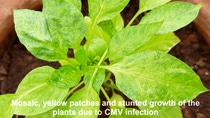
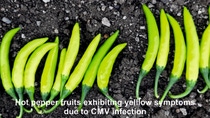
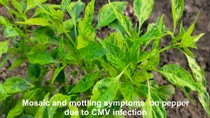
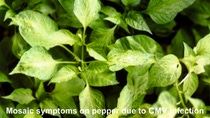
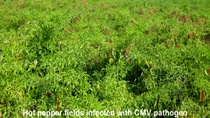
Causal Agent:
Cucumber Mosaic Virus (CMV)
Vector:
Many Aphids species
Taxonomy Genus:
Cucumovirus in the family Bromoviridae.
Distribution:
Across the globe including India.
Identification:
Symptoms are generally varies depending upon the variety, age of the plant at the time of infection. The most common symptoms include severe mosaic, mottling, chlorosis, necrosis and distortion in leaves. Leaves may become narrow, distorted and mottled. Infected plants are usually stunted, and the fruits distorted with occasional concentric rings. Infection of young plants results in unmarketable fruit and severe yield losses. CMV can induce severe damage, which often lead to economical losses, as it has been proven to cause 10-20% loss of yield. The presence of this virus in a plant can be confirmed serologically (ELISA), molecularly (PCR), or by host range tests.
Life Cycle/ Favourable Environmental conditions for the disease:
Generally, aphids appear in November and remain active till April. Cloudy and moist weather favors rapid multiplication of the pest. This virus has a wide host range. CMV can overwinter in perennial plants and weeds. Cucumber mosaic virus occurs worldwide and is considered as very important disease in temperate, tropic and subtropic regions of the world. Crop losses vary from year to year since the amount of disease occurrence depends upon the number of aphids available for virus transmission in the spring or fall when the crops are established as determined by geographical location. If the spring or fall is cool and wet, aphid numbers are decreased and virus spread is sporadic, with infected plants primarily located in rows bordering the edges of the field. However, if the spring or fall is warmer with less frequent rains, aphid populations increase rapidly on perennial crops that harbor CMV, and virus spreads rapidly into crops that are young and especially attractive to migrating aphids. In such cases, infection rates may approach 100% and the crop may have to be abandoned. On average, losses of 10-20% are common, and in some instances the crop may still be harvested but is of poorer quality and appearance.
Disease Transmission:
This virus is transmitted by Aphids in a non-persistent manner (Stylet borne) and more than 80 aphids species associated with CMV transmission. Acquisition and transmission occur in very short time. The aphids cannot retain the virus for long time and have to acquire the virus repeatedly for the transmission to new plants. This virus is also mechanically transmitted. The Virus host plants can be a seasonal and perennial also. some may show clear symptoms while others are symptomless carriers.
Control:
Management at Nursery
- Growing of nursery under Nylon net cover (60-80) mesh.
- Soil application of microbial enriched FYM, neem cake @ 1kg sq mt before sowing of seeds in the nursery beds.
- Cocopeat should be enriched with bioagents and seedling to be raised in portrays.
- Prior to transplantation the seedling should be sprayed with systemic insecticides/ seedlings dip in system insecticides.
- Hardening of seedlings to be done with nylon net cover.
Management at Main fields
- Growing of border crop of two rows of Maize/jowar
- Mulching with silver or white polythene agro mulch sheet
- Use of yellow and blue colour sticky traps 30 to 50 per acre
- Spraying systemic insecticides combined with neem-based pesticides, don’t use the same chemicals, always use the alternative chemicals on every spray schedule.
- Growing of virus tolerant verities is the good option line Armour F1
Chilli Veinal Mottle
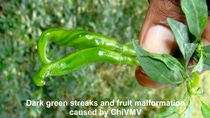
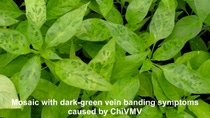
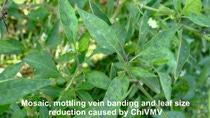
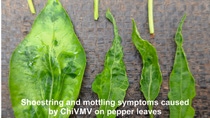
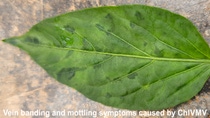
Causal Agent:
Chilli veinal mottle virus (ChiVMV)
Vector:
Many species of aphids
Taxonomy Genus:
Potyvirus in the family Potyviridae
Distribution:
Asia
Identification:
Typically, leaves of infected plants develop a mottle or mosaic with dark-green vein banding. Plants infected when young usually are stunted, with dark-green streaks on stems. Most flowers drop before fruit set. Affected fruit may be mottled and deformed. Symptom severity is dependent upon the variety, infecting strain and age of the host at the time of infection.
Life Cycle/ Favourable Environmental conditions for the disease:
Peppers, tobacco, tomatoes and weeds such as Physalis spp. are hosts of ChiVMV. Tropical climates support the continuous presence of ChiVMV and its vectors. ChiVMV is transmitted by several species of aphids in a non-persistent manner and can also be transmitted mechanically through pruning and grafting. There is no evidence of seed transmission.
Disease Transmission:
This virus is transmitted by Aphids in a non-persistent manner (Stylet borne) and more than 80 aphids species associated with ChiVMV transmission. Acquisition and transmission occur in very short time. The aphids cannot retain the virus for long time and have to acquire the virus repeatedly for the transmission to new plants. This virus is also mechanically transmitted. The Virus host plants can be a seasonal and perennial also, some may show clear symptoms while others are symptomless carriers.
Control:
Management at Nursery
- Growing of nursery under Nylon net cover (60-80) mesh.
- Soil application of microbial enriched FYM, neem cake @ 1kg sq mt before sowing of seeds in the nursery beds.
- Cocopeat should be enriched with bioagents and seedling to be raised in portrays.
- Prior to transplantation the seedling should be sprayed with systemic insecticides/ seedlings dip in system insecticides.
- Hardening of seedlings to be done with nylon net cover.
Management at Main fields
- Growing of border crop of two rows of Maize/jowar
- Reflective Mulching with silver or white polythene agro mulch sheet
- Use of yellow and blue colour sticky traps 30 to 40 per acre
- Spraying systemic insecticides combined with neem-based pesticides, don’t use the same chemicals, always use the alternative chemicals on every spray schedule.
- Growing of virus tolerant varieties and virus free transplants.
Anthracnose
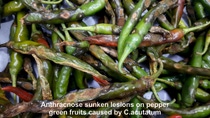
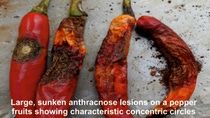
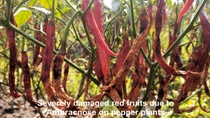
Causal Agent:
Colletotrichum capsici, C. gloeosporioides, C. acutatum.
Distribution:
Worldwide
Pathogen
Anthracnose is caused by a group of fungi within the genus Colletotrichum. The three main species associated with peppers are C. capsici, C. gloeosporioides and C. acutatum, but there are several species that may cause this disease. Many species of Colletotrichum infect more than one host and more than one species may infect a single host. In India, C. capsici and C. gloeosporioides is more likely to infect mature fruit, whereas C. acutatum is more likely to infect immature fruit in recent years. Anthracnose is known to infect a wide range of commercial pepper plants and related solanaceous crops. Extensive outbreaks have occurred specially on hot peppers.
Identification:
All above-ground parts of the plant are susceptible to infection, but the fruits are most impacted by this disease. Ripe and over-ripe fruit tend to be more susceptible, but pepper plants can become infected at any growth stage, as well as at post-harvest. Fruit lesions are the economically important and most common symptom of this disease. Initially, the lesions are small, depressed, and circular. As the disease progresses, they become much larger and develop mats of salmon to pink-colored spores, causing their surface to appear wet and gelatinous. The centers of the lesions can range from tan or orange to brown or black. The colored spore mats seen on the fruit features are characteristic of this disease. Concentric circles commonly surround the lesions, eventually, the entire fruit will rot. Anthracnose can cause a latent infection where contaminated. Based on species, some species can affect both green and ripe fruit, but symptoms are usually not visible until fruit ripen and turn red. immature fruits may not show symptoms of disease until fully mature.
Life Cycle/ Favourable Environmental conditions for the disease:
The pathogen prefers warm, wet weather, temperatures of around 27 to 28⁰C and high levels of precipitation. It can over-winter in soil in the form of microsclerotia, which are very small, compact masses of hardened mycelium containing nutrient reserves for extreme conditions. Rain splash carries fungal spores from infected soil, plant debris, and/or fruits onto nearby plants. Excess rain can lead to higher rates of infection and crop loss. Fog and dew are conducive to disease development. Rain disseminates the pathogen’s spores and often leads to severe losses, especially if fruit are wounded.
Control:
- Use of resistant or tolerant varieties
- Crops should be rotated with non-solanaceous plants for 2-3 year.
- Do not use overhead irrigation. Irrigation systems that limit water splash in the field.
- Additionally, limiting field operations when plants are wet will help reduce spread.
- Regular weeding should be performed near transplants along with the removal of solanaceous weeds.
- Destruction of crop residue. After harvesting fruit, fields should be immediately cleaned.
- Frequently monitor fields for signs of disease and remove infected fruit immediately.
- Adequate drainage in the fields, good drainage is necessary to reduce extra moisture and waterlogging of crops.
Phytophthora Blight
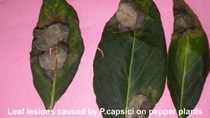
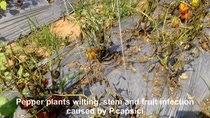
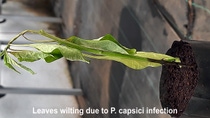
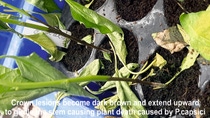
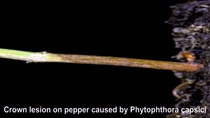
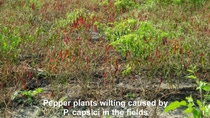
Causal Agent:
Phytophthora capsici
Distribution:
Worldwide
Identification:
P. capsici can produce a wide variety of symptoms depending on the specific plant part involved and the stage of the crop. Since P. capsici is a soilborne pathogen, symptoms usually first develop at the soil line in the roots and crown, however, infection can occur at any plant part where water splashes soil onto the plant. The most common symptoms on peppers are crown rot and fruit rot. Under wet conditions, disease tends to manifest itself as wilting of the plants followed by plant death. As the disease progresses, crown lesions become dark brown and extend upward to girdle the stem causing plant death. Pepper fruits can become infected when rain and overhead irrigation splash infested soil onto emerging fruits. Fruit rot appears as water-soaked areas that eventually become covered with white powdery to cottony mold. Leaf symptoms start as small irregular, water-soaked lesions.
Life Cycle/ Favourable Environmental conditions for the disease:
Optimal conditions for disease development are: Excessive rainfall or overhead irrigation, Saturated soils. Warm temperatures (75 to 90°F). Rainfall, wet soils and poor drainage generally favor disease development and spread. In climates where irrigation is used, extended periods of soil wetness also favor the root and crown rot, stage of Phytophthora Blight. Disease spread usually follows the direction of surface water run-off. In climates with heavy rainfall, foliar blight, as well as root and crown rot occur. Splashing rain and wind spread disease from plant to plant. Spread can also occur when soil is carried on equipment and footwear. Phytophthora capsici can survive in the soil for years in tropical, subtropical and temperate climates.
Disease Transmission:
Water and movement of infested soil via transplants, farm equipment, or tools are the main contributors to pathogen dissemination. Infested irrigation water is a significant source of inoculum and P. capsici zoospores can easily be carried via run-off from rivers, creeks, ditches, streams, and ponds fed by canals.
Control:
- Select fields with no history of Phytophthora blight, if possible.
- Select fields that did not have peppers, cucurbits, eggplants, or tomatoes for at least 3 years.
- Crop rotation is an excellent disease management strategy for most vegetable diseases. Rotate to non-susceptible or non-host (corn, cabbage, cauliflower, mustard, wheat) crops for at least 3 years.
- Select well-drained fields and avoid planting into low-lying areas.
- Do not over-irrigate (avoid excessive irrigation). Discontinue overhead irrigation if the disease is present.
- Do not irrigate from a pond that contains water drained from an infested field.
- Transplants the peppers on raised beds (a minimum of 9 inches high). Beds should be prepared prior to transplanting.
- Scout and remove infected plants to reduce the number of spores produced in the field. This will help to prevent movement of spores from infected plants to healthy plants during subsequent rainfalls.
- Chemical control commonly soil drenching early in the season (at 7-day interval, alternate).
- Plant resistant varieties, if available.
Powdery Mildew
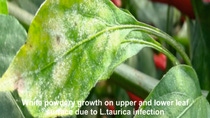
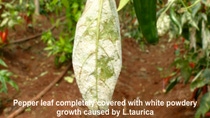
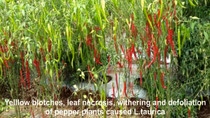
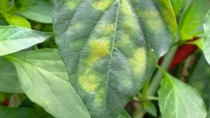
Causal Agent:
Leveillula taurica
Distribution:
Worldwide
Identification:
Light green to bright-yellow, irregularly-shaped blotches develop on upper leaf surfaces of older leaves; the lesion centers later turn necrotic. Younger leaves remain unaffected until they mature. The disease progresses from older to younger leaves. The older leaves are affected first, and later, the disease progresses up towards new growth. Drooping of infected leaves and upwards curling of leaf edges may be observed, and such leaves often die and fall off the plant. Fruit may exhibit sunburn if the plant is defoliated. The fungus usually is on the leaf's lower side and can sporulate profusely. Severely defoliated plants will affect the fruits development and quality and affect the yield.
Life Cycle/Favourable Environmental conditions for the disease:
The L.taurica starts when spores (known as conidia) land on a pepper leaf. Infections can occur over a wide temperature range (19-33°C) at high or low humidity. Spores germinate, penetrate through the leaf surface, and produce mycelia that grow into the leaf tissue. The pathogen parasitizes the plant using it as a food source. It initially grows within the leaf for a latency period of 18-21 days. After the latency, the fungus grows thorough the leaf openings (stomata) and colonizes on the under surface of the leaf and where it produces numerous, fine strands or stalks called conidiophores. These conidiophores become visible as white fluffy patches, i.e., mildew colonies, and produce numerous conidiospores (spores) which are borne singly on each conidiophore. Air currents within the greenhouse carry the spores to other plants. Spores are dispersed further through the greenhouse vents. In addition to dispersal by air currents or wind, powdery mildew can spread from surrounding infected ornamental plants and weeds, and by workers on their clothing. Repeated generations (disease cycles) of powdery mildew can lead to severe outbreaks of the disease.
Control:
- Use resistant or tolerant varieties.
- Plants crops with sufficient spacing to allow for good ventilation and light penetration through the canopy.
- Remove infected leaves when first spot appears
- Do not touch healthy plants after touching infected plants.
- A thick layer of mulch can prevent the dispersal of spores from the soil up to onto the leaves
- Fertilize with a balanced nutrient supply or avoid excessive fertigation.
- Plow in or remove the plants residues after the crop harvest.
Thrips
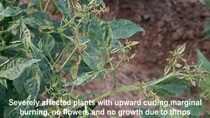
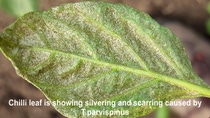
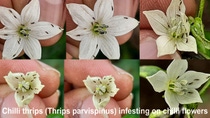
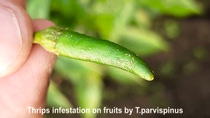
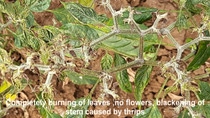
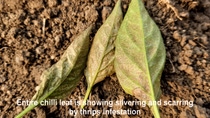
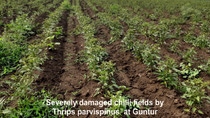
Causal Agent:
Scirtothrips dorsalis and Thrips parvispinus
Distribution:
Worldwide
Pest:
The common thrips of Chilli is leaf thrips in India is Scirtothrips dorsalis. The new thrips is identified as Thrips parvispinus called as Black Flower Thrips recently. Even though it was reported in India back 2015 on tobacco, this year it has adopted to hot pepper and causing severe damage to crop major Chilli growing districts of Karnataka, Andhra Pradesh & Telangana.
Identification:
Thrips are the sucking type of insects which infests the Chilli crops. Thrips feeds under the leaves surface and sucks the sap by direct feeding especially on tender leaves, flowers and developing fruits which causes crinkling and upward curling of leaves. Elongated petiole, drying of leaves, Flower dropping, stunted growth and scrapping of Chilli fruit which in turn causes economic losses to farmers. Leaf brittling, stunted plant growth, mal formation of plant parts are common symptoms with high rate of flower deformation.
Life Cycle/ Favourable Environmental conditions for the disease:
The life cycle of Chilli thrips is similar to that of other common thrips species, such as the western flower thrips. Egg to adult development is completed within 12 to 20 days, depending on temperature and host plant species. Females insert their eggs inside plant tissue on or near leaf veins, terminal plant parts and floral structures. Eggs hatch in 2-4 days under optimal conditions but may take longer at lower temperatures. Immature thrips pass through two larval stages (1st and 2nd instars). The first instar lasts for 2-4 days and the second instar is completed in 3-6 days. During this time larvae actively feed on tender young plant growth, consuming enough food to complete development to the adult stage. Fully-grown larvae molt into a non-feeding, prepupal stage, which may last up to 24 hours, and then pupate on protected plant parts, leaf litter or in the soil near the base of the plant. The pupal stage lasts 2-3 days. In all, Chilli thrips may complete their life cycle in 12 to 22 days and females generally deposit 60 to 200 eggs in their lifetime.
Control:
- Select resistant varieties (if available for target market).
- FYM or Compost should be applied at the time of land preparation 25-30 days prior to planting to enhance plant immunity and favorable micro biome in soil.
- Apply Metarhizium anisopliae &/or Beuveria bassiana to soil at planting & earthing up @ 10 kg/ac.
- Reflective mulches discourage pest build up & prevent pupation in soil (30-90%)
- Barrier crop – to prevent/interrupt easy spread of thrips- Plant two thick rows of maize/sorghum/bajra around the plot and one row for every 10-20 rows of Chilli or capsicum. This also encourages natural enemies of thrips.
- Root dip/spray the seedlings 8-24 hrs. before transplanting with thiamethoxam (Actara) 0.5 g/l.
- Apply neem cake and vermicompost @ 250 kg & 1000 kg /ac at planting (mulched) or 125 kg and 500 kg at planting & 125 kg & 500 kg at earthing up.
- Application of azadirachtin 10,000ppm either single application or in combination
- Use sticky traps to monitor & manage thrips populations @ 50-60 traps /acre (blue and white)- Change/replenish @ 10-15 -30 days depending upon pest load /weather).
- Keep the plot and surroundings weed free- to discourage pest multiplication
- Sprinkler irrigation/water spray discourages pest multiplication.
- Remove heavily infested plants/parts from the field.
- Irrigate the crop regularly with optimum water and follow balanced application of NPK, avoid excessive nitrogen and do follow split application of N.
- Do vegetable special/micronutrients sprays 3-5 times starting from 45 DAP to induce plant immunity.
- If pest pressure high, switch to insecticides-Avoid repeating an insecticide for a second time as well as within a month
- If pest pressure high, switch to insecticides.
- Ginger and garlic extraction along with insecticides spray on Armour, helping to rejuvenate and flowering.
- Net house production (60 mesh size) may protect in the production fields.
